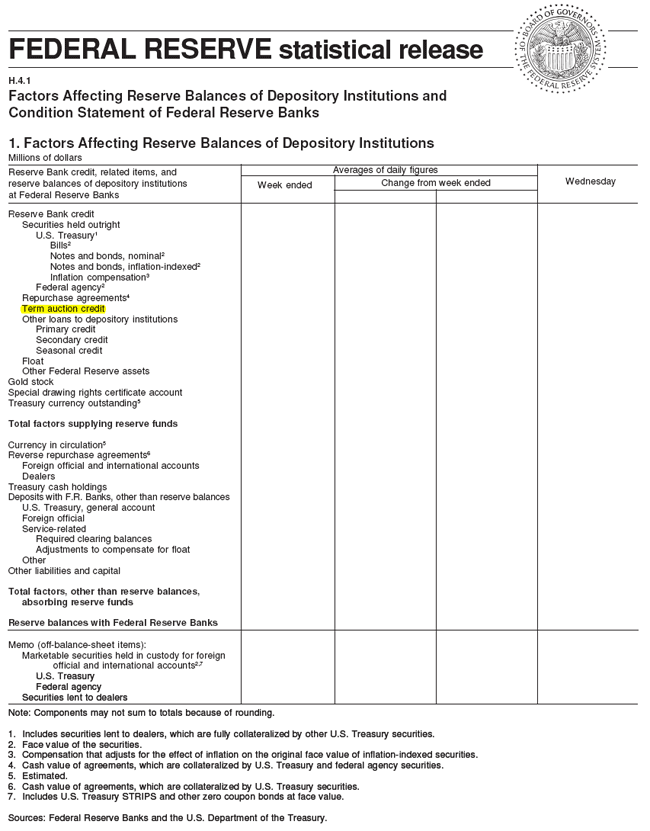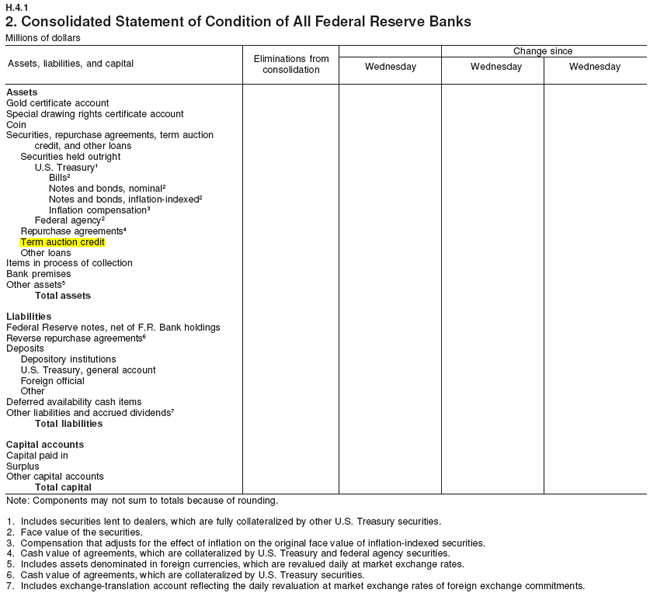FRB Other lending facilities Credit and Liquidity Programs and the Balance Sheet
Post on: 24 Август, 2015 No Comment

Term Asset-Backed Securities Loan Facility
In November 2008, the Federal Reserve announced the creation of the Term Asset-Backed Securities Loan Facility (TALF) under section 13(3) of the Federal Reserve Act. The TALF was a funding facility under which the Federal Reserve Bank of New York (FRBNY) issued loans with terms of up to five years to holders of eligible asset-backed securities (ABS). The TALF was intended to assist the financial markets in accommodating the credit needs of consumers and businesses of all sizes by facilitating the issuance of ABS collateralized by a variety of consumer and business loans; it was also intended to improve the market conditions for ABS more generally. Operational details and other information about the facility are presented on the FRBNY’s public website.
Eligible collateral initially included U.S. dollar-denominated ABS that (1) were backed by student loans, auto loans, credit card loans, and loans guaranteed by the Small Business Administration (SBA) and (2) had a credit rating in the highest investment-grade rating category from two or more approved rating agencies and did not have a credit rating below the highest investment-grade rating category from a major rating agency. The loans provided through the TALF were non-recourse loans, meaning that the borrower’s obligation to repay the loan could have been fulfilled by surrendering the collateral. Borrowers committed their own risk capital in the form of haircuts against the collateral, which served as the borrower’s equity in the transaction and acted as a buffer for absorbing any decline in the collateral’s value in the event the loan was not repaid.
Any ABS surrendered to the FRBNY in conjunction with a TALF loan would have been sold to a special purpose vehicle, TALF LLC, established for the specific purpose of managing such assets. Because the FRBNY was the primary beneficiary of the TALF LLC, the assets and liabilities of the LLC were consolidated onto the books of the FRBNY. Purchases of these securities by TALF LLC would have been at a price equal to the TALF loan plus accrued but unpaid interest, and would have been funded through the commitment fees received by the LLC and any interest the LLC had earned on its investments. Prior to January 15, 2013, the U.S. Treasury’s Troubled Asset Relief Program (TARP) committed backup funding to TALF LLC, providing credit protection to the FRBNY. However, after that point in time the accumulated fees and income collected through TALF and held by TALF LLC exceeded the remaining amount of TALF loans outstanding and, accordingly, the TARP credit protection commitment was terminated.
On February 10, 2009, the Federal Reserve Board announced that it would consider expanding the size of the TALF to as much as $1 trillion and potentially broaden the eligible collateral to encompass other types of newly issued AAA-rated asset-backed securities, such as ABS backed by commercial mortgages or private-label (non-agency) ABS backed by residential mortgages. Any expansion of the TALF would be supported by the Treasury providing additional funds from the TARP.
On March 19, 2009, the Federal Reserve Board announced that starting in April 2009, the set of eligible collateral for TALF loans was being expanded to include ABS backed by loans or leases related to business equipment, leases of vehicle fleets, floorplan loans, and mortgage servicing advances.
On March 23, 2009, the Federal Reserve and the Treasury announced that they were planning on expanding the list of eligible collateral for TALF loans to include previously issued securities—so called legacy securities—as a complement to the Treasury’s Public Private Investment Program. Eligible securities are expected to include certain non-agency RMBS that were originally rated AAA and outstanding commercial mortgage-backed securities and ABS that are rated AAA.
On May 1, 2009, the Federal Reserve announced that, starting in June 2009, newly issued CMBS and securities backed by insurance premium finance loans would be eligible collateral under the TALF. The Federal Reserve also authorized TALF loans with maturities of five years, available for the June funding, to finance purchases of CMBS, ABS backed by student loans, and ABS backed by loans guaranteed by the Small Business Administration. The Federal Reserve indicated that up to $100 billion of TALF loans could have five-year maturities and that some of the interest on collateral financed with a five-year loan may be diverted toward an accelerated repayment of the loan, especially in the fourth and fifth years.
On May 19, 2009, the Federal Reserve announced that starting in July 2009, certain high-quality CMBS issued before January 1, 2009 (legacy CMBS) would become eligible collateral under the TALF. The Federal Reserve indicated that eligible newly issued and legacy CMBS must have at least two AAA ratings from a list of approved ratings agencies—DBRS, Fitch Ratings, Moody’s Investors Service, Realpoint, or Standard & Poor’s—and must not have a rating below AAA from any of these rating agencies. More broadly, the Federal Reserve announced that it was formalizing procedures for determining the set of rating agencies whose ratings would be accepted for various types of eligible collateral in the Federal Reserve’s credit programs.
On August 17, 2009, the Federal Reserve and the Treasury announced that they were holding in abeyance any further expansion in the types of collateral eligible for the TALF.
On December 4, 2009, the Federal Reserve announced a formal process for determining the set of rating agencies whose ratings would be accepted for establishing the eligibility of ABS to be pledged as collateral to the TALF. Another change announced at that time requires the FRBNY to conduct a formal risk assessment of all proposed collateral in addition to continuing to require that collateral for TALF loans receive two AAA ratings from TALF-eligible NRSROs. These changes were intended to promote competition among credit rating agencies, ensure appropriate protection against credit risk for the U.S. taxpayer, and ensure that TALF collateral continues to comply with the existing high standards for credit quality, transparency, and simplicity of structure.
The Federal Reserve Board initially authorized the offering of new TALF loans through December 31, 2009, but subsequently authorized an extension of the program until March 31, 2010, for loans against newly issued ABS and legacy CMBS, and until June 30, 2010, for loans against newly issued CMBS. Consistent with announcements, the Federal Reserve closed the TALF for new loan extensions against newly issued CMBS on June 30, 2010, and for new loans against all other types of collateral on March 31, 2010. The last outstanding TALF loan matured on October 29, 2014.
TALF LLC was formally terminated in November 2014, after distributing the accumulated fees and income earned by the LLC since inception to the Treasury and the FRBNY in accordance with the TALF LLC agreements. The Treasury received 90 percent of the distributions, and the FRBNY received 10 percent.
Commercial Paper Funding Facility

The Commercial Paper Funding Facility (CPFF) was a facility, authorized under section 13(3) of the Federal Reserve Act, that enhanced liquidity in the commercial paper markets. The CPFF provided a liquidity backstop to U.S. issuers of commercial paper through a specially created limited liability company (LLC), the CPFF LLC. This LLC purchased three-month unsecured and asset-backed commercial paper directly from eligible issuers. The Federal Reserve provided financing to the LLC through the CPFF. The Federal Reserve’s lending to the LLC was secured by all of the assets of the LLC and by the retention of up-front fees paid by the issuers. Collateral policies for the CPFF are discussed in the collateral and rate setting and risk management sections of this site.
The CPFF was announced on October 7, 2008. It was administered by the Federal Reserve Bank of New York (FRBNY). Because the FRBNY was the sole beneficiary of the CPFF LLC, the assets and liabilities of the LLC were consolidated onto the balance sheet of the FRBNY. The CPFF was closed on February 1, 2010. While no new loans will be made after that date, credit remained outstanding until all commercial paper held by CPFF LCC matured. Detailed information on the CPFF is provided on this website.
Asset-Backed Commercial Paper Money Market Mutual Fund Liquidity Facility
The Asset-Backed Commercial Paper Money Market Mutual Fund Liquidity Facility (AMLF) was a lending facility that financed the purchases of high-quality asset-backed commercial paper (ABCP) from money market mutual funds by U.S. depository institutions and bank holding companies. The program was intended to assist money funds that hold such paper to meet the demands for redemptions by investors and to foster liquidity in the ABCP market and money markets more generally. Collateral policies for the AMLF are discussed in the collateral and rate setting and risk management sections of this website. The loans extended through the AMLF were non-recourse loans, meaning that the borrower’s obligation to repay the loan could have been fulfilled by surrendering the collateral. To help ensure that the AMLF was used for its intended purpose of providing a temporary liquidity backstop to money market mutual funds (MMMFs), the Federal Reserve established a redemption threshold whereby a MMMF must have experienced material outflows—defined as at least 5 percent of net assets in a single day or at least 10 percent of net assets within the prior five business days—before it could sell ABCP that would be eligible collateral for AMLF loans to depository institutions and bank holding companies. Any eligible ABCP purchased from a MMMF that experienced redemptions at these thresholds could be pledged to AMLF at any time within the five business days following the date that the threshold level of redemptions was reached. The terms and conditions of the facility and other information are presented on this website.
The initiation of the AMLF, announced in September 2008, relied on authority under section 13(3) of the Federal Reserve Act. It was administered by the Federal Reserve Bank of Boston, which was authorized to make AMLF loans to eligible borrowers in all twelve Federal Reserve districts. The AMLF was closed on February 1, 2010.
Money Market Investor Funding Facility
The Money Market Investor Funding Facility (MMIFF), announced in October 2008 and authorized under section 13(3) of the Federal Reserve Act, was intended to provide liquidity to U.S. money market mutual funds and certain other money market investors, thereby increasing their ability to meet redemption requests and hence their willingness to invest in money market instruments, particularly term money market instruments. Under the MMIFF, the FRBNY could provide senior secured funding to a series of LLCs that were established with the private sector. The FRBNY would finance the purchase of eligible assets from eligible investors by these LLCs. Eligible assets included U.S. dollar-denominated certificates of deposit and commercial paper that are issued by highly rated financial institutions and have remaining maturities of 90 days or less. Collateral policies for the MMIFF are discussed in the archived versions of the collateral and rate setting and risk management sections of this website. Initially, only U.S. money market mutual funds were eligible investors. Subsequently, the Federal Reserve made a number of other money market investors eligible participants, including U.S.-based securities-lending cash-collateral reinvestment funds, portfolios, and accounts (securities lenders); and U.S.-based investment funds that operate in a manner similar to money market mutual funds, such as certain local government investment pools, common trust funds, and collective investment funds.
The MMIFF expired on October 30, 2009. Other information on the MMIFF is provided on the Federal Reserve Board’s public website.














